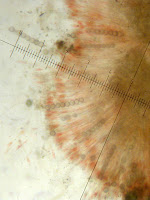On Sunday I helped out at a habitat management work party at Blackrock Quarry, just north of the A465 near the Clydach Gorge. I only had time for a quick poke about at the base of the limestone quarry face near where I was working, but I was pleased to see plenty of Gymnostomum viridulum growing on soil in crevices - a new species for me. Under the microscope it was good to see numerous multicellular gemmae in the leaf axils.
In the same habitat, and probably of greater interest, was what I think is one of the bryoparasitic ascomycetes which Sam brought to our attention recently. A single orange apothecium caught my eye among a patch of Trichostomum crispulum (I managed to break it in two during collection - see photo below). Microscopic inspection revealed the spore structure nicely (photos below) but I have failed to key it out satisfactorily using the German website. The apothecium was large by the standards of this group, with a diameter of 5mm. No species are listed on the website as parasitic on Trichostomum, though some use the related Tortella and Weissia.
Any thoughts welcome. Also, I'm not sure how best to preserve it for future examination!





The spores appear reticulate, probably with low straight walls. This is therefore Lamprospora rather than Octospora. There are several spp which have spores like that, judging by the website, so other factors eg the narrow membranous margin to the apothecium need to be considered. It seems closest to L miniata sl, which is a calcicole that uses many hosts. I would suggest you dry it along with the host moss, but wonder whether carefully dissecting out the fungus and the stems immediately around it and housing them in a minipacket inside the main packet would be sensible. Then best sent to Kew or even Germany?!
ReplyDeleteThanks Sam. I also concluded it was Lamprospora, but my microscope was at the limit of its capabilities and I couldn't make out the ornamentation on the spores very clearly.
ReplyDeleteI'll dry it out as you suggest. Do you have a contact at Kew?
Not an area I'm familiar with, but looks like a Scutellinia sp to me - a quick Google search shows minor has spherical spores?
ReplyDeleteThat looks a good call Barry, and it would explain the relatiely large size. I'm only familiar with the species with much more obvious eyelashes which grow on dead wood, perhaps Scutellinia scutellata.
ReplyDeleteIt does look like a Scutellinia. One of the clues is the eyelash-like bristles around the discs - they are called eyelash fungi and most of them are orange or reddish orange. Most guide books only show one species, S. scutellata, which it isn't. There are about 25 species in Europe. Fortunately, most of them have elliptical spores and your specimen has spherical spores. That narrows it down to 5 species. The spores look less than 25 microns in diameter and they seem to have fairly stout spines.So, a likely candidate is S. trechispora (sometimes called Sphaerospora trechispora or Ciliaria asperior). Scutellinia trechispora may also be the same species as that called S. armatospora. It likes calcareous conditions and given that your specimen was associated with Trichostomum crispulum, that sort of fits. Sorry, Scutellinia is a bit of a nightmare.
ReplyDeleteThanks Charles, that's very helpful. I'm familiar with the eyelash fungi with obvious inward-pointing eyelashes (perhaps scutellata) but this one didn't have obvious lashes pointing inwards.
ReplyDeleteI tried using this online key:
http://fungi.myspecies.info/content/scutellinia-key#
and thought it might be trechispora or one of the closely related species. Looking at the septa of the marginal hairs might help...will try that.
OK George, good luck with that. I'll expect a progress report on Friday!
ReplyDeleteWell spotted guys - my ramblings about Octospora were based on semi-asleep views of George's pics at 06:00 on my iPod (never a good approach to critical ID). I've collected S trechispora from a calcareous quarry in Carms and also from a dune slack (with T crispulum I think) in Pembs.
ReplyDeleteSorry for misleading you Sam!
ReplyDelete